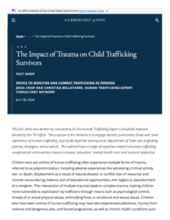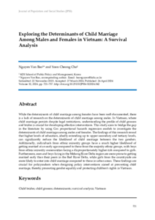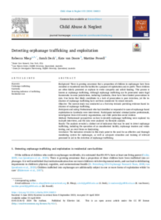Displaying 31 - 40 of 468
В настоящем докладе Независимый эксперт по вопросу об осуществлении прав человека людьми с альбинизмом излагает точки зрения, результаты осу-ществления совместного исследовательского проекта и рекомендации по реше-нию повседневных проблем и улучшению жизненной ситуации детей с альби-низмом в контексте права на семейную жизнь.
This webinar unpacks lessons learnt from successful parenting and caregiver interventions in lower-middle-income countries.
Around the globe, an estimated 27 million people are exploited for labor, services, and commercial sex. Through force, fraud, and coercion, they are made to toil in fields and factories, in restaurants and residences. Traffickers prey on some of the world’s most marginalized and vulnerable individuals – profiting from their plight. Among these individuals are children who are forced into criminality, sex trafficking, child soldiering, and in some countries the forced marriage of children has been defined as a form of exploitation.
This webinar showcased global approaches to strengthening norms and values that support positive, gender-equitable relationships and non-violent problem solving as one of the strategies to prevent violence against children as outlined in INPIRE. It focused on the lessons learned, challenges, adaptations and key ingredients of successful interventions.
This fact sheet was engages with experts, particularly those with lived experience of human trafficking, to provide expertise and input on the U.S. Department of State anti-trafficking policies, strategies, and products. The authors have a range of expertise related to human trafficking, marginalized communities, trauma recovery, education, mental health care, and survivor leadership.
This global report describes the process used to determine the priorities for research on the intersections between violence against children and violence against women, and the top 10 research questions identified.
While the determinants of child marriage among females have been well-documented, there is a lack of research on the determinants of child marriage among males. This study aims to bridge the gap in the literature to investigate the determinants of child marriage among males and females in Vietnam.
The purpose of this U.S.-based study was to compare adolescent and caregiver reports of adolescent adverse childhood experiences (ACEs) and their relationship with current adolescent depression and to analyze the relationship between ACEs and depression.
Although orphanage trafficking can be prosecuted under legal frameworks in some jurisdictions, including Cambodia, there have been limited prosecutions to date. One factor that likely contributes to a lack of prosecution is poor detection, yet the indicators of orphanage trafficking have not been considered by extant research. The current study was conducted as a first step towards providing evidence-based indicators of orphanage trafficking.
Muluka Anne Mitti-Drummond, UN Independent Expert on the Enjoyment of Rights of Persons living with Albinism highlights how the conversation on the enjoyment of rights of children with albinism will advance the advocacy on this topic.







